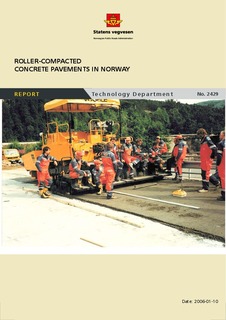Roller-compacted concrete pavements in Norway
Dahlhaug, J.E.; Haugødegård, T.; Jenssen, L.; Markey, I.; Melby, K.; Ohnstad, P.Ø.; Strømme, O.L.; Sæveraas, O.
Report
Permanent lenke
http://hdl.handle.net/11250/192956Utgivelsesdato
2006Metadata
Vis full innførselSamlinger
- Teknologirapporter [132]
Sammendrag
This report contains a paper which was prepared for the seventh international conference of the bearing capacity of roads, railways and airfields in Trondheim, June 2005 and supplied afterwards.
Roller-compacted concrete, as the name suggests, is concrete that in its unhardened state will support a roller while being compacted. During the period 1985 - 1995 a total of 68 km of concrete roads was constructed in Norway using this method, of which almost 60 km was in tunnels. The annual average daily traffic (AADT) on these stretches ranges from 200 to 10 000 vehicles per day, the majority having low traffic volumes. By 2005, almost 15 km of these concrete roads will have been paved over with asphalt. The remaining 53 km are located almost entirely in tunnels or on bridges.
Experience indicates that:
- compressive strength should be greater than C45
- thickness of concrete wearing surface should be greater than 150 mm plus rut depth
- spacing between joints should not be greater than 6 - 8 m
- the full width of the road should be cast in one operation to avoid bad longitudinal joints
- only good quality aggregate with a max diameter of 22 mm should be used
- dust has been a problem in some tunnels during the first few years of operation
- quality of workmanship during casting has large implications for the final product
- annual measurements show very small increases in rut depth
- good maintenance and repair methods need to be further developed
- the performance of the concrete wearing surface is so good in some tunnels that it should last 50-100 years without any major maintenance
